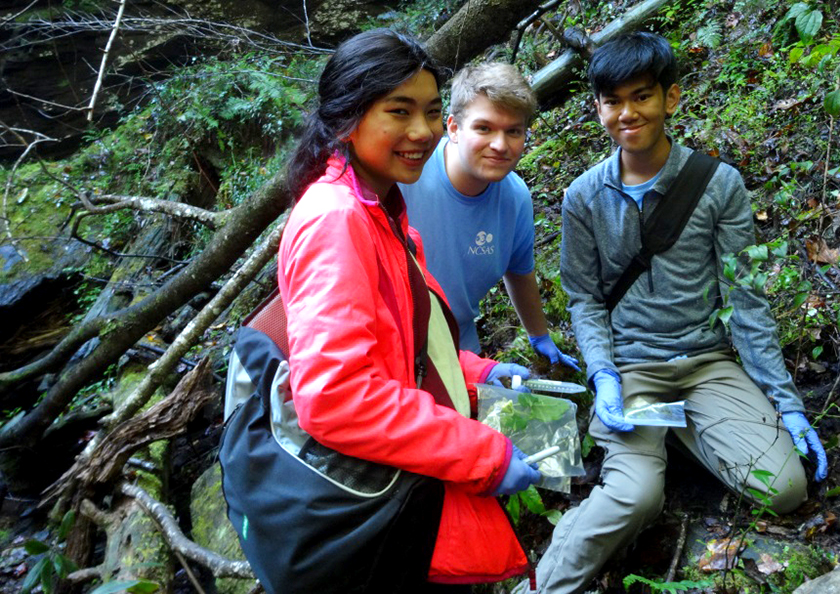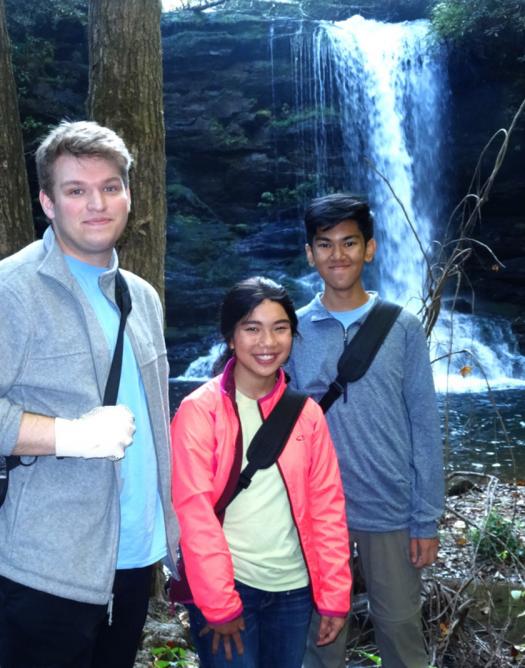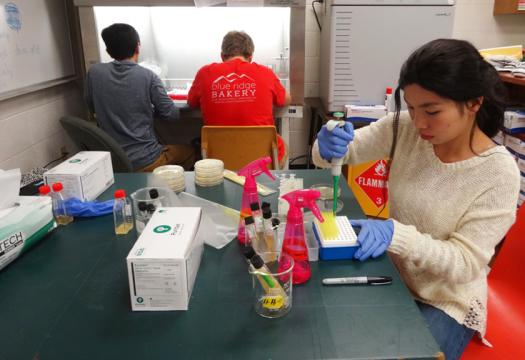STEM Outreach, Young & Amazing
Finding a natural source of medicine in waterfall plants

When you think of western medicine, you wouldn’t necessarily think of herbs or other plant sources. But three high school students from rural Brevard, North Carolina believe we can find novel sources of natural medicine in plants, specifically those next to waterfalls. Plants in these areas, called spray cliffs, are constantly misted by the spray of water, making them vulnerable to waterborne disease.
Brevard Senior High School students Matthew Bailey, John Nguyen, and Nicole Rideout participate in T.I.M.E. 4 Real Science, a student-led science inquiry class. Recently, they explored Gorges State Park in search of natural sources of medicine. They trekked down a precarious gorge with Gorges Park Rangers to the Lower Bearwallow Falls and collected spray cliff plants.
T.I.M.E. 4 Real Science allows high school students to work on their own research projects and participate in science competitions. It enabled these three high schoolers to seek research opportunities in their local community.
“My involvement in T.I.M.E 4 Real Science has given me life-changing experiences,” John said. “What makes the program so significant is its impact on students living in a rural area. It gives rural students a chance to conduct collegiate level research and access to equipment and resources they wouldn’t have otherwise.”

Transylvania County, where the students live, is a temperate rainforest teeming with biodiverse plants and animals, which makes it a perfect area to pursue endophytic research, John explained. He was inspired to find local research opportunities after viewing a documentary by Gary Strobel, an American microbiologist and naturalist, about endophytes in tropical rainforests.
Endophytes — microorganisms found in and around plant cell walls — produce organic compounds that can inhibit the growth of bacterial diseases, fungal diseases, malaria, cancer, and more.
“We focused on endophytes found in plants living in spray cliff communities,” John said. “We sampled plants from a spray cliff that is virtually untraversed by the general public.”
The team wanted to study increasing antimicrobial resistance around the world. “New types of vaccines and medicine are produced every year to combat resistant strains of bacteria and fungi,” John explained. “With the increasing global population, diseases will soon outnumber the resources we have to combat them. Since endophytes are found in every plant on Earth, the possibilities for medicinal research are innumerable.”
Back in their high school lab, the students isolated and identified endophytes from the plants they had brought back with them. They performed three types of antimicrobial assays on the endophytes, to determine which samples showed inhibition against four test organisms. They found that 29 plants showed inhibition against E. coli, Bacillus cereus, Candida albicans, and Cryphonectria parasitica, more commonly known as chestnut blight. Roughly 67 percent of their samples showed inhibition against at least one test organism.
Unlike pharmaceuticals and prescription medicine, natural medicine isn’t created in a lab. Natural sources of medicine, like endophytes, have evolved to act in symbiotic relationships with nature.

Their work was selected by their local science fair for recognition as a Society for Science & the Public Community Innovation Award winner. This award honors students participating in science fairs around the world who are making a difference in their communities. In 2018, the Society rewarded 20 young scientists with $500 prizes — and Nicole, Matthew, and John were three of them. They split the prize award.
“Receiving the award was an honor,” Nicole said. “This project is just one of many examples that shows young people have the ability to change the world we live in today.”
Nicole expressed that a challenging constraint of the research process was working in a high school lab and 90-minute time periods. “We spent many late afternoons and early evenings in the lab to take readings and collect data,” Nicole said. “We even trekked to school on snow days to ensure we got the data we needed.”

“Even the greatest discoveries can be made in your high school lab,” Nicole explained. “STEM can be explored anywhere at any time, and we’re honored to serve as motivation for other students working in rural locations.”
“To all of the young people, and especially young girls and women, who are interested in STEM, I want to encourage you to keep being curious,” Nicole said. “Don’t be afraid to enter a field that has long been dominated by men, because no matter who you are, if you have the passion, drive, and motivation, you will be unstoppable.”


